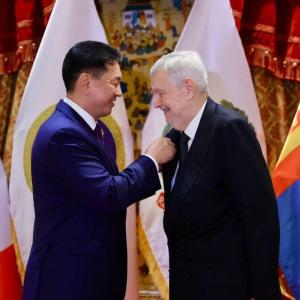"Culture and art - immunity for any nation during globalization"
The Mongol Messenger
Peter K.Marsh holding fiddles crafted by his friend and master fiddler maker B. Bayarsaikhan (Pegasus)
Interview by Ts.Tumenbayar
Peter K. Marsh is an ethnomusicologist and music historian with broad interdisciplinary training and experience as a teacher, scholar, and administrator, and a specialist in the area of Asian music and culture. He is a specialist in ethnomusicology and area studies, principally the music and culture of Mongolia and Inner Asia, and has written extensively on issues related to musical tradition and modernity in Mongolia.
His book, “The Horse-head Fiddle and the Reimagination of Tradition in Mongolia, Current Issues in Ethnomusicology Series” (New York: Routledge Press, 2014) examines the development of two-string folk fiddles and their "folklorization" in Mongolian folk music in the twentieth and twenty-first centuries. He has also written on Mongolian popular music, including the history and development of Mongolian pop and hip-hop music.
Dr. Marsh has served as lecturer at a number of important events, including the Stanford University Asian Art Festival of 2010; Smithsonian Folklife Festival of 2002, called "The Silk Road: Connecting Cultures, Creating Trust," which in that year drew 1.5 million visitors to the National Mall in Washington DC; the 20th Annual Cowboy Poetry Gathering in 2004 at the Western Folklife Center in Elko NV; and the "Festival of Мongolia" in 2000 at the American Museum of Natural History, New York City.
He served as Founding Director of the American Center for Mongolian Studies, an academic-oriented non-government organization based in Ulaanbaatar, Mongolia, where he assisted United States-based faculty, students and scholars from many disciplines in conducting their academic research in the region. I am presenting you, dear readers, an online interview with him.
- Since its evolvement, mankind has divided the world as West and East. And it is the reason to consider that western and eastern culture is different. However, there are some people who view that there is not any language required for human inner feeling, sense, music and painting to be accepted. Concerning the mentioned, what do you think? And, do the people all over the world accept Morin Huur, traditional long-drawling song and works of modern Mongolian composers?
I think you are asking about the idea that music is a “universal language.” Ethnomusicologists believe that music is universal (every known culture around the world has something resembling “music”), but its meaning is not necessarily so. Meaning in music and art is rooted in culture, and culture is shaped by a group’s sense of themselves in their place and time. I once heard a famous biologist define culture as “The answer to the question: how do we live here, where we are?”
When long song singers of the Gobi, for instance, speak about the origins and meanings of long songs, they often point to the nomadic herders’ connections with their natural and spiritual environment. This style of song emerged from and is intimately connected with the Gobi and the ways of life of the nomadic peoples of the region.
When Norovbanzad egch /ed. well-known Mongolian folk singer/ sings a long song, she is expressing this deep cultural connection to her homeland and its people, and the people of her homeland who hear her can intuitively understand this connection. The songs she sings and the way she sings them resembles a coded language that she and her audiences share. This is why we say that music is closely bound with the culture and environment in which it emerged; the two are inseparable.
Now, when Norovbanzad traveled to Moscow or Tokyo, she performed on the stages of concert halls for urban audiences that had little-to-no connection with the Gobi, or even rural ways of life. The music these people listened to on a regular basis might have been mass-mediated popular song or western classical music.
When they listened to Norovbanzad do a beautiful rendition of a Mongolian long song, what did those audiences hear? Did they hear the music with the same depth of understanding as the people of the Gobi? Likely not. More likely, they related what they heard with musical expressions that they were familiar with. They may have appreciated the melodies she produced or been moved by the power of her voice, but the meaning of this music to these non-Mongolian audiences could not have been the same as with her Gobi audiences.
That said, some types of Mongolian music are immediately understandable to non-Mongolian audiences. Mongolian classical composers, for instance, who have since the early 20th century been trained in the West or in western-styled schools of music, create music that western audiences will be very familiar with. The same can be said about Mongolian music that mixes elements of Mongolian folk music or song with elements of western popular music. The Mongolians who create these fusions share many cultural ways with non-Mongolian audiences around the world.
Contemporary Mongolian society is very cosmopolitan! I think many forms of contemporary folk, pop, and classical music in Mongolian will find enthusiastic audiences around the world. For an example of this, just look at the success of The Hu!

“I cherish the opportunities I had to meet and interview many famous Mongolian musicians, such as the tuulich Avirmed in 1994.”
- During the process of globalization, the largest nations will “swallow” the minors. Some people consider that there would be no difference between west and east. On the other hand, some consider that cultural difference will become more conspicuous. Which do you agree with? Can culture and art be the immunity for any nation to stay on its own during such process?
Again, just look at the example of The Hu. They have been successful because of the process of globalization. The members of the group have said in interviews that they grew up listening to western popular music and participating in western popular culture (for example, at the opening minute of the music video of their song Yuve, yuve yu). They used the same globalized avenues of media and technology to take western popular music back to the west, albeit in a slightly different form.
Everyone who hears The Hu identifies it as “Mongolian” and their music as “Hunnu rock.” Spend any time watching “reaction videos” on YouTube (made by western pop music artists and fans) and you’ll hear people marveling at the beautiful images of the Mongolian countryside in their videos or at the idea that Chinggis Khan might actually have been a wise and powerful leader of his people.
So, is this a case of globalization “swallowing” Mongolian culture? I think not. Mongolians have long absorbed western (and now global) cultural trends and then adapted them to reflect their own unique vision and message. Mongolian artists have been very good at this in the 20th and 21st centuries.
- Eminent scientist Albert Einstein got the ideas for his discoveries by listening to Mozart’s works and playing them on piano and violin. What are your views on whether art, especially, music affects the development of science? On the other hand, whether can music works be considered at scientific discovery level?
The example of Albert Einstein shows just how integral creativity and imagination is to our lives. Even those who perceive themselves as engaging in work that is “purely scientific” or “rational” can use their creativity and imagination in ways similar to artists. This idea has been widely explored in western literature.
The American physicist Stephon Alexander recently wrote about Einstein and music in his book The Jazz of Physics: “Einstein is famous for what is perhaps his greatest gift: the ability to transcend mathematical limitations with physical intuition. He would improvise using ‘thought experiments,’ which provided him with a mental picture of the outcome of experiments no one could perform.”
- In your first works, there is a study on Mongolian rock pop. Why have you begun studying Morin Huur and long-drawling song?
My original research was on the morin khuur, specifically, and Mongolian cultural history, more generally. I first came to Ulaanbaatar in 1994, and then came back for research visits many times between then and 2004. During this period, I spent a great deal of time interviewing fiddlers and other traditional musicians in Ulaanbaatar and the countryside.
I worked with many great scholars of Mongolian music, such as Dr. J.Enebish and Dr. L.Erdenechimeg, and developed very close friendships while there. My first book (published in 2009) told the story of the development of the morin khuur and, with it, the development of Mongolian music from ancient times to the present. I spent considerable time focusing on how the instrument and its place in Mongolian society changed in the 20th and 21st centuries.
From the very beginning, I was also interested in the development of Mongolian pop-rock. I was lucky to become friends with Chinggis Khaany Jargalsaikhan, who helped me to understand this history from his point of view. I found that the forces that shaped the development of pop music in Mongolia from the late 1960s on were similar to those that shaped modern folk music institutions in the same period.
- There are 2 types of morin huur in Mongolia, one is with manufactured wires and the other with strings made of horsehair. Which do you truly accept?
As an ethnomusicologist, it’s not my role to accept one choice or the other. I’m interested in learning about why a musician would choose one or the other. I’m more interested in understanding the “truth” held by others.
- How many years do you think morin huur and long-drawling song of Mongolia continue to live further?
Music grows out of and are nurtured by culture. Mongolians have created and maintained the morin khuur and long songs because they have helped to answer the question, “How do we live here, where we are?” So long as this society believes these instruments and musical forms are meaningful, they will survive.
- There is a sensation amidst music fans that Mongolian ethnic band “HU” shocked western world of metal rock. Whether is it right to understand that the band “HU” reached such success through their performance of epic-ode type work by combining traditional musical instruments of Mongolia with modern new technology?
Yes, of course. A group of Mongolian heavy metal rock musicians imitating the style of western heavy metal musicians would not have interested western audiences, no matter how talented they were. What has fascinated audiences in the west and around the world is not only the band’s sound-fusing western heavy metal and Mongolian folk music-but also its unique message and image. The band has crafted an artistic brand that sounds original and deeply felt. As I said before, western audiences are used to “fusion” music, but what catches their attention is music that seems honest. The Hu creates music that seems to reflect who they are and what they feel as young Mongolian men in our world today.
- You have done substantial studies on folk music of Mongolia, especially, the morin huur and long-drawling song which are the pride and symbol of Mongolians. I have also heard that you have made several presentations on scientific conferences concerning how morin huur works have been inherited in modern times. So far, how do you assess the outcome of your research works?
I’ve been doing research on the morin khuur for almost three decades now. What I seek to accomplish through my writings and talks is to help people to understand both the beauty and the history of this instrument and the ancient and diverse musical tradition of which it is a part.
When I started this work, back in the early 1990s, almost nothing was known about Mongolian music in the West. While some books and articles on the subject had been published by Russian authors in the mid-20th century, the only book available to western audiences about Mongolian music was published in by the Danish explorer and musicologist Henning Haslund Christensen in 1942, which was based on research he conducted in Inner Mongolia in the 1920s and ‘30s.
From then until the early 1990s, as your readers will know, it was very difficult for westerners to enter Mongolia. When travel restrictions ended, I was one of the first Americans to begin extensive field research there, and one of the only ones to focus on music. I like to think that the writings I’ve done and speeches I’ve given have helped to lay the foundation for the study of Mongolian music as a legitimate area of study in the United States. I’m very pleased that there are now many young researchers interested in pursuing the study of Mongolian music.
- You have founded the American Culture Center in Mongolia. The center conducts activity at the Natsagdorj Library of Ulaanbaatar. What do you think whether you have achieved main goal for founding the center? Have you had been in touch with the center?
I served as its founding director of the American Center for Mongolian Studies (ACMS) from 2004-2006. The Executive director, and the one who established the organization, was Dr. Charles Krusekopf. The primary goal of the ACMS was to assist American (and other non-Mongolian) students and scholars in doing research work in Mongolia, such as by assisting them with locating funding, visas, translators, and contacts with their Mongolian counterparts.
Our secondary goal was to help Mongolian students and scholars with their research work, such as by assisting them with locating funding opportunities to study or conduct research in the U.S. and with making contacts with their American counterparts. Essentially, we wanted to help Mongolian and non-Mongolian students and scholars to meet and collaborate, and I think this has been achieved in the nearly 17 years the Center has been in operation.
- Do you agree that not only Mongolian composers, but also composers from other countries are creating their works by adapting them with modern technology? In other words, should composers create their works according to technology advancement? Or should they create their works according to human psychology and social development?
I’m sorry, I don’t really understand these questions. Composers are artists, and as such, they draw from their imagination and creativity to create their art. They also may use a range of technologies, from a simple pencil and paper to sophisticated electronics. But art is ultimately about the vision of the artist.
- When cows listen to Bach music, they produce more milk. Instead, mice after listening to modern rock music have gone mad. What is the reason for that?
These sound like anecdotes. I’d like to see what the science really is here. Animals may indeed respond to music, but can we really know what these responses mean? We have to be wary of anthropomorphizing or attributing human characteristics to animal behavior.
- At what place are works of modern morin huur, national and symphonic orchestra in world’s music development? Which works, do you think, should be emphasized?
Oh, they are all a part of the world’s musical development, without question. These include all the operas, symphonies, and solo and chamber music works that Mongolian artists have created, from Gonchigsumlaa and Mordorj, through to N.Jantsannorov guai and contemporary composers today. All of this music deserves to be studied as part of the musical record of modern civilization.
- At present, what artistic works and research are you working on?
I'm Professor of music at California State University, East Bay (located in the San Francisco Bay Area). I teach Ethnomusicology and Western music history. I am currently preparing a website dedicated to the musical research of Henning Haslund Christiansen. He brought back from his Mongolian expeditions musical instruments and rare photographs and recordings of musicians and singers, which are currently housed at the State Museum of Denmark in Copenhagen. I’d like to make them available to the world through this website. I think many Mongolians would be very interested in seeing these materials.
 Peter K.Marsh interviewing an axmad (elderly) fiddler in Ulaanbaatar in 2017.
Peter K.Marsh interviewing an axmad (elderly) fiddler in Ulaanbaatar in 2017. Ulaanbaatar
Ulaanbaatar













































































